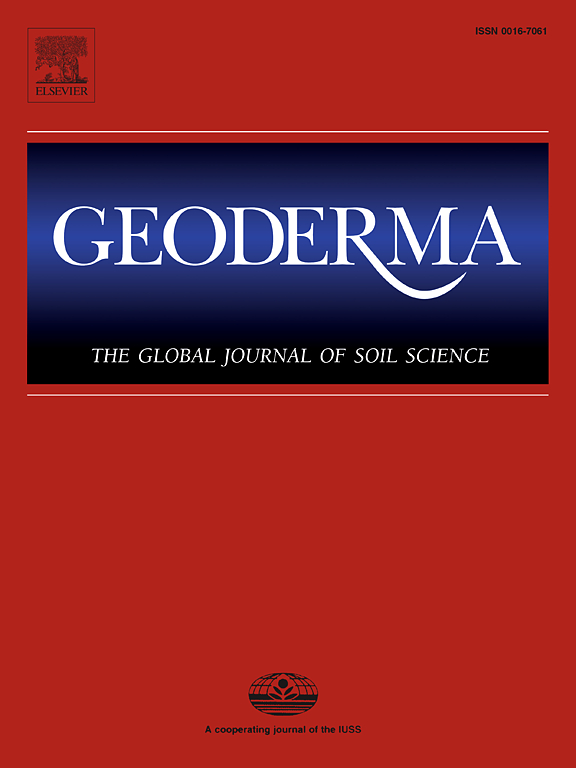Assessing soil quality in association with frozen ground in the source areas of the Yangtze and Yellow Rivers, Qinghai-Tibet Plateau
IF 5.6
1区 农林科学
Q1 SOIL SCIENCE
引用次数: 0
Abstract
Frozen-ground environments represent one of the most fragile ecosystems in the source areas of the Yangtze and Yellow Rivers (SAYYR), characterized by persistently low temperatures and slow decomposition of soil organic matter, which sustains substantial soil organic carbon reserves. As climate warming intensifies, ecological stressors in the SAYYR increasingly threaten soil conditions. However, research on soil quality within the SAYYR remains scarce. This study systematically assessed soil quality through vegetation and soil surveys and analyses across 12 sites in the SAYYR. A soil quality index (SQI) was calculated using a selected minimum dataset comprising total nitrogen (TN), total phosphorus (TP), total kilocalorie (TK), available phosphorus (AP), available kilocalorie (AK), and total dissolved salt (TDS). Results revealed that the CLQ site, abundant in organic matter, exhibited the largest average SQI at 0.59, while the CMEH site located in seasonally frozen ground recorded the lowest value (0.26), highlighting the influence of frozen soil types on soil quality. The regional average SQI in the SAYYR was 0.44, indicating moderate soil quality. Diagnostic modeling identified TN as the primary constraint on soil quality in the SAYYR, with an average obstacle rate of 22.4%. Further analysis showed that fractional vegetation coverage and aboveground biomass were key determinants of soil quality in the SAYYR. The interaction between fractional vegetation coverage and mean annual ground temperature explained 58% of soil quality variability, the highest among tested factors. Additionally, the interactions of altitude with vegetation cover and vegetation cover with aboveground biomass accounted for 47.6% and 45.1% of variability, respectively. Results underscored the necessity of integrating vegetation characteristics, altitude, and frozen-ground thermal conditions to interpret soil quality variations in the SAYYR. This study provided valuable scientific insights and theoretical foundations for guiding ecological conservation, climate adaptation, and frozen-ground preservation in the SAYYR.

青藏高原长江黄河源区冻土土壤质量评价
冻土环境是长江黄河源区最脆弱的生态系统之一,其特征是持续低温,土壤有机质分解缓慢,维持着大量的土壤有机碳储量。随着气候变暖的加剧,SAYYR的生态压力源日益威胁土壤条件。然而,对SAYYR内土壤质量的研究仍然很少。本研究通过对SAYYR地区12个站点的植被和土壤调查和分析,系统地评估了土壤质量。采用全氮(TN)、全磷(TP)、总千卡(TK)、有效磷(AP)、有效千卡(AK)和总溶解盐(TDS)组成的最小数据集计算土壤质量指数(SQI)。结果表明,有机质含量丰富的CLQ站点的平均SQI最大,为0.59,而位于季节冻土的CMEH站点的SQI最小,为0.26,突出了冻土类型对土壤质量的影响。SAYYR区域平均SQI为0.44,土壤质量为中等。诊断模型确定全氮是SAYYR土壤质量的主要制约因素,平均障碍率为22.4%。进一步分析表明,植被覆盖度和地上生物量是SAYYR土壤质量的关键决定因素。植被覆盖度与年平均地温的相互作用解释了58%的土壤质量变异,是所有因子中最高的。海拔与植被覆盖度、植被覆盖度与地上生物量的相互作用分别占变异率的47.6%和45.1%。结果强调了综合植被特征、海拔和冻土热条件来解释SAYYR土壤质量变化的必要性。该研究为指导青藏高原的生态保护、气候适应和冻土保护提供了有价值的科学见解和理论基础。
本文章由计算机程序翻译,如有差异,请以英文原文为准。
求助全文
约1分钟内获得全文
求助全文
来源期刊

Geoderma
农林科学-土壤科学
CiteScore
11.80
自引率
6.60%
发文量
597
审稿时长
58 days
期刊介绍:
Geoderma - the global journal of soil science - welcomes authors, readers and soil research from all parts of the world, encourages worldwide soil studies, and embraces all aspects of soil science and its associated pedagogy. The journal particularly welcomes interdisciplinary work focusing on dynamic soil processes and functions across space and time.
 求助内容:
求助内容: 应助结果提醒方式:
应助结果提醒方式:


